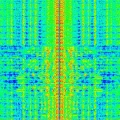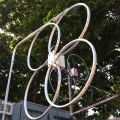KA7U
About
- Username
- KA7U
- Joined
- Visits
- 3,402
- Last Active
- Roles
- Member
- Points
- 3
-
Syllabic Voice Squelch
Syllabic squelch would be nice. Currently I set the Threshold in the AGC panel to subdue the noise floor and find that a minimal voice will be audible if the audio gain is turned up. It isn't as elegant, but probably misses less weak signals. The only voice squelch I have to use is a Micom2es and I find it requires a substantial signal to activate reliably. I've never been overly impressed with that radio though. I bet the KiwiSDR could produce better results. -
kiwid takes 100% CPU, occasionally starves system
-
LZ1AQ LNA and a 1.2 meter copper loop antenna.
A report on the ongoing experimenting with the home brew ZL1AQ loop amplifier and the commercial version. I have now made a total of 6 LZ1AQ amplifiers, 3 using matched 2N2222 transistors and 3 using 2N5109 transistors. I've experimented with single loops and dual loops in orthogonal planes like the image in G8JNJ's post above. According to my observations of the noise floor using the KiwiSDR, the amps using the 2N5109 transistors exhibit a better noise floor by a considerable margin, over 10dBm on 160 meters and observably more on the lower frequencies. Generally, the entire 30 MHz band spread is noticeably improved with the 2N5109 transistors. The 2N2222 transistors I used had a typical HFE of 214.
The commercial version that I purchased has considerably more gain than the DIY model but once again it also has a higher noise floor and the additional gain has required notch filters to reduce local high powered stations, that the DIY boards don't require, as they have less gain. The commercial board is very sensitive at VLF and is very nice with many options that make it ideal for a wider variety of antenna configurations.
I have two problems with the boards currently available at https://easyeda.com/doxnairobi/zl1aq-loop-amp-ron-morell , I used the 2N2222 footprint and it makes it a bit tight to use the 2N5109, and if you use a RJ45 socket that accepts cords horizontal to the board, it will be incorrect, so use the RJ45 socket that plugs in from the top. I might get around to changing these two issues... It takes me about 4 hours to make the amp and the balun RJ45 to BNC board. https://easyeda.com/doxnairobi/2-1_balun , and again, I've got the RJ45 plug backwards if you use a horizontal plug. There is nothing stopping you from modifying these boards before having them produced. The last order was $2.00 for 10 boards + shipping and the parts I ordered. The parts weren't much either. Mostly it just takes time to figure out how to do it and wait for them to show up.
I've worked with 4 different amp designs and I think the LZ1AQ is quite competitive with the other designs. Thanks to G8JNJ for recommending it.
Ron
KA7U -
LZ1AQ LNA and a 1.2 meter copper loop antenna.
A report on the ongoing experimenting with the home brew ZL1AQ loop amplifier and the commercial version. I have now made a total of 6 LZ1AQ amplifiers, 3 using matched 2N2222 transistors and 3 using 2N5109 transistors. I've experimented with single loops and dual loops in orthogonal planes like the image in G8JNJ's post above. According to my observations of the noise floor using the KiwiSDR, the amps using the 2N5109 transistors exhibit a better noise floor by a considerable margin, over 10dBm on 160 meters and observably more on the lower frequencies. Generally, the entire 30 MHz band spread is noticeably improved with the 2N5109 transistors. The 2N2222 transistors I used had a typical HFE of 214.
The commercial version that I purchased has considerably more gain than the DIY model but once again it also has a higher noise floor and the additional gain has required notch filters to reduce local high powered stations, that the DIY boards don't require, as they have less gain. The commercial board is very sensitive at VLF and is very nice with many options that make it ideal for a wider variety of antenna configurations.
I have two problems with the boards currently available at https://easyeda.com/doxnairobi/zl1aq-loop-amp-ron-morell , I used the 2N2222 footprint and it makes it a bit tight to use the 2N5109, and if you use a RJ45 socket that accepts cords horizontal to the board, it will be incorrect, so use the RJ45 socket that plugs in from the top. I might get around to changing these two issues... It takes me about 4 hours to make the amp and the balun RJ45 to BNC board. https://easyeda.com/doxnairobi/2-1_balun , and again, I've got the RJ45 plug backwards if you use a horizontal plug. There is nothing stopping you from modifying these boards before having them produced. The last order was $2.00 for 10 boards + shipping and the parts I ordered. The parts weren't much either. Mostly it just takes time to figure out how to do it and wait for them to show up.
I've worked with 4 different amp designs and I think the LZ1AQ is quite competitive with the other designs. Thanks to G8JNJ for recommending it.
Ron
KA7U -
LZ1AQ LNA and a 1.2 meter copper loop antenna.
A report on the ongoing experimenting with the home brew ZL1AQ loop amplifier and the commercial version. I have now made a total of 6 LZ1AQ amplifiers, 3 using matched 2N2222 transistors and 3 using 2N5109 transistors. I've experimented with single loops and dual loops in orthogonal planes like the image in G8JNJ's post above. According to my observations of the noise floor using the KiwiSDR, the amps using the 2N5109 transistors exhibit a better noise floor by a considerable margin, over 10dBm on 160 meters and observably more on the lower frequencies. Generally, the entire 30 MHz band spread is noticeably improved with the 2N5109 transistors. The 2N2222 transistors I used had a typical HFE of 214.
The commercial version that I purchased has considerably more gain than the DIY model but once again it also has a higher noise floor and the additional gain has required notch filters to reduce local high powered stations, that the DIY boards don't require, as they have less gain. The commercial board is very sensitive at VLF and is very nice with many options that make it ideal for a wider variety of antenna configurations.
I have two problems with the boards currently available at https://easyeda.com/doxnairobi/zl1aq-loop-amp-ron-morell , I used the 2N2222 footprint and it makes it a bit tight to use the 2N5109, and if you use a RJ45 socket that accepts cords horizontal to the board, it will be incorrect, so use the RJ45 socket that plugs in from the top. I might get around to changing these two issues... It takes me about 4 hours to make the amp and the balun RJ45 to BNC board. https://easyeda.com/doxnairobi/2-1_balun , and again, I've got the RJ45 plug backwards if you use a horizontal plug. There is nothing stopping you from modifying these boards before having them produced. The last order was $2.00 for 10 boards + shipping and the parts I ordered. The parts weren't much either. Mostly it just takes time to figure out how to do it and wait for them to show up.
I've worked with 4 different amp designs and I think the LZ1AQ is quite competitive with the other designs. Thanks to G8JNJ for recommending it.
Ron
KA7U





